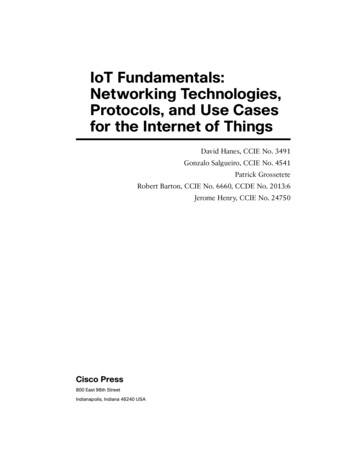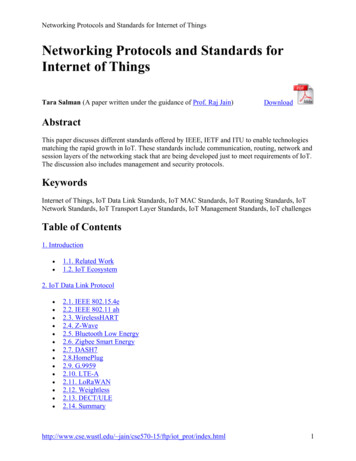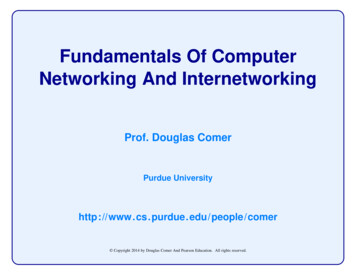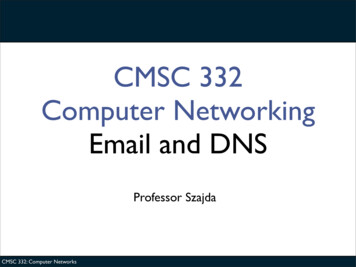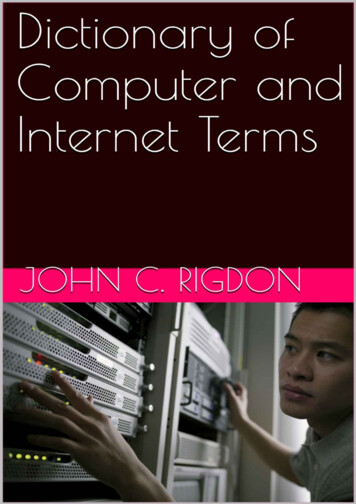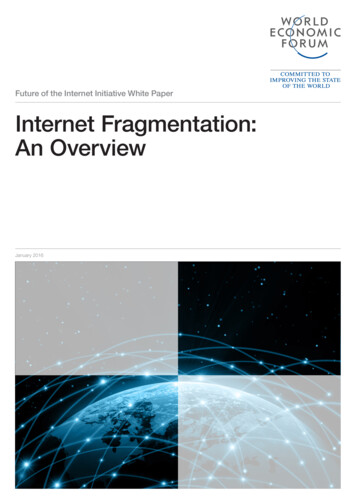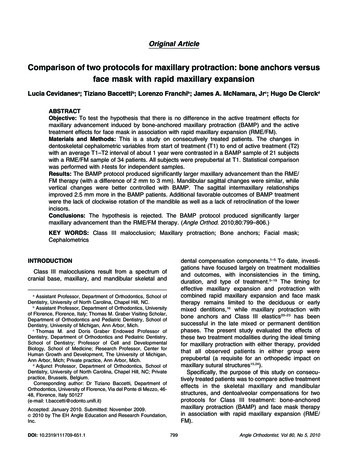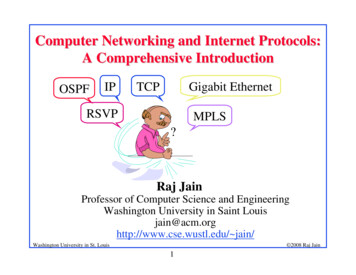
Transcription
Computer Networking and Internet Protocols:A Comprehensive IntroductionOSPFIPTCPGigabit EthernetRSVPMPLS?Raj JainProfessor of Computer Science and EngineeringWashington University in Saint Louisjain@acm.orghttp://www.cse.wustl.edu/ jain/Washington University in St. Louis 2008 Raj Jain1
OverviewIP: Addressing, forwarding, IPv6, TCP! Ethernet! Quality of Service (QoS): RSVP! Multi-protocol Label Switching (MPLS)! Route Discovery Protocols : RIP, OSPF, BGP! Wireless networking! Optical networking!Washington University in St. Louis 2008 Raj Jain2
1. Introduction to TCP/IPTCP/IP Reference Model! Internet Protocol (IP)! Forwarding an IP Datagram! IP Datagram Format! IPv6 Enhancements! Domain Name Service! TCP: Key Features! User Datagram Protocol (UDP)!Washington University in St. Louis 2008 Raj Jain3
2. EthernetCarrier Sense Multiple Access with CollisionDetection (CSMA/CD)! IEEE 802 Address Format! Interconnection Devices! Distance-B/W Principle! Gigabit Ethernet! Spanning Tree! 10Gbps Ethernet PHYs! Metro Ethernet Services!Washington University in St. Louis 2008 Raj Jain4
3. Quality of Service (QoS)ATM QoS and Issues! Integrated Services and RSVP! Differentiated Services:Expedited and Assured Forwarding! Subnet Bandwidth Manager (SBM)! COPS Protocol for Policy! IEEE 802.1D Model!Washington University in St. Louis 2008 Raj Jain5
4. MPLSRouting vs Switching! Label Stacks! Label Distribution Protocol (LDP)! RSVP Extensions! Traffic Engineering! Traffic Trunks! Traffic Engineering Extensions to OSPF and IS-IS!Washington University in St. Louis 2008 Raj Jain6
5. Routing ProtocolsBuilding Routing Tables! Routing Information Protocol Version 1 (RIP V1)! RIP V2! OSPF! BGP and IDRP.!Washington University in St. Louis 2008 Raj Jain7
6. Wireless NetworksRecent advances in wireless PHY! WiMAX Broadband Wireless Access! Cellular Telephony Generations! WiMAX vs LTE! 4G: IMT-Advanced! 700 MHz!Washington University in St. Louis 2008 Raj Jain8
7. Optical NetworksRecent DWDM Records! OEO vs OOO Switches! More Wavelengths! Ultra-Long Haul Transmission! Passive Optical Networks! IP over DWDM: MPλS, GMPLS! Free Space Optical Comm! Optical Packet Switching!Washington University in St. Louis 2008 Raj Jain9
Day 1: Schedule (Tentative)10:00-10:15! 10:15-11:30! 11:30-11:45! 11:45-1:15! 1:15-2:00! 2:00-3:15! 3:15-3:30! 3:30-5:00!Course IntroductionInternet Protocol (IP), IPv6Coffee BreakDNS, TCPLunch BreakMetro EthernetCoffee BreakQuality of ServiceWashington University in St. Louis 2008 Raj Jain10
Day 2: Schedule (Tentative)10:00-11:00! 11:00-11:15! 11:15-12:15! 12:15-1:00! 1:00-2:15! 2:15-2:30! 2:30-4:00!MPLS, MPLS-TECoffee BreakRouting ProtocolsLunch BreakWireless NetworkingCoffee BreakOptical NetworkingWashington University in St. Louis 2008 Raj Jain11
Pre-TestCheck if you know the difference between:" Private addresses and public addresses" Class C vs Class A addresses" Extension header vs base header" Distance vector vs link state routing" Inter-domain vs intra-domain routing" Universal vs multicast bit" Spanning tree vs IS-IS" UBR vs ABR" DiffServ vs IntServ" RSVP vs LDP" CDMA vs OFDMA" OOO vs OEO optical switching" MPLS vs GMPLS" Routing vs switchingWashington University in St. Louis!12 2008 Raj Jain
Pre-Test (Cont)If you checked more than 7 items,you may not gain much from this course.! If you checked only a few or none, don’t worry. Thiscourse will cover all this and much more.!Washington University in St. Louis 2008 Raj Jain13
DisclaimersThis course covers a lot of topics! These topics are normally taught in 3 quarter-courses! Fundamental and basics will be covered! You will need to read RFC’s for detailed info! This course has been designed specifically for you.Please feel free to ask questions, make comments,agree or disagree.! More discussion More relevant topics!Washington University in St. Louis 2008 Raj Jain14
Student Questionnaire!!Name (Optional):Computer networking courses taken:!Telecom Networking background:!What do you want covered in this course:Washington University in St. Louis 2008 Raj Jain15
Introduction toTCP/IPRaj JainProfessor of Computer Science and EngineeringWashington University in Saint LouisSaint Louis, MO, USAjain@acm.orghttp://www.cse.wustl.edu/ jain/Washington University in St. Louis 2008 Raj Jain16
Overview1.2.3.4.5.6.7.8.TCP/IP Reference ModelInternet Protocol (IP)Forwarding an IP DatagramIP Datagram FormatIPv6 EnhancementsDomain Name ServiceTCP: Key FeaturesUser Datagram Protocol (UDP)Washington University in St. Louis 2008 Raj Jain17
TCP/IP Reference ModelTCP Transport Control Protocol! IP Internet Protocol (Routing)!TCP/IP Ref ModelApplicationTransportTCP/IP ProtocolsFTPTelnet HTTPTCPUDPOSI Ref etworkIPNetworkHost toNetworkEther Packet Point-tonet Radio PointDatalinkWashington University in St. LouisPhysical 2008 Raj Jain18
Layered Packet Format!Nth layer control info ispassed as N-1th layerdata.FTPFTP DataHeaderTCPHeaderTCP DataIPHeaderEthernetHeaderIP DataEthernet DataWashington University in St. LouisEthernetTrailer 2008 Raj Jain19
Internetworking!Inter-network NetworkNetworkCollection of networksConnected via routersRouterRouterWashington University in St. LouisNetworkNetwork 2008 Raj Jain20
Internet Collection of Networks!Any computer can talk to any other computerNet 2Net 3Net 1Net 4Washington University in St. Louis 2008 Raj Jain21
Internet Protocol (IP)Layer 3 protocol that forwards datagrams acrossinternet! Uses routing tables prepared by routing protocols,e.g., Open Shortest Path First (OSPF),Routing Information Protocol (RIP)! Connectionless servicevs connection-oriented (circuits)!Washington University in St. Louis 2008 Raj Jain22
IP Address!Class A:(1 3 bytes)! ClassB:(2 2 bytes)! ClassC:(3 1 bytes)0 Network17Local24bits10 NetworkLocal21416 bits110NetworkLocal3218 bits1110Host Group (Multicast)428bits! ClassD:! Local Subnet Host (Variable length)RouterWashington University in St. LouisRouterSubnet23 2008 Raj Jain
SubnettingAll hosts on a subnetwork have the same prefix.Position of the prefix is indicated by a “subnet mask”! Example: First 23 bits subnetAddress: 10010100 10101000 00010000 11110001Mask:11111111 11111111 11111110 00000000.AND.10010100 10101000 00010000 00000000!NetworkSubnet 1Subnet 2Washington University in St. LouisSubnet n 2008 Raj Jain24
An Addressing 0.0.1 erRouter192.5.48.3RouterRouter192.5.48192.5.48All hosts on a network have the same network prefixWashington University in St. LouisFig 14.625 2008 Raj Jain
Special IP Addresses!!!!!!All-0 host suffix Network AddressAll-0s This computer(In some old networks: 0.0.0.0 broadcast. Not used.)All-0s network This network.E.g., 0.0.0.2 Host 2 on this networkAll-1 host suffix All hosts on the destination net (directedbroadcast),All-0 host suffix Berkeley directed broadcast addressAll-1s All hosts on this net (limited broadcast) Subnet number cannot be all 1127.*.*.* Looback through IP layerWashington University in St. Louis 2008 Raj Jain26
Private AddressesAny organization can use these inside their networkCan’t go on the internet. [RFC 1918]! 10.0.0.0 - 10.255.255.255 (10/8 prefix)! 172.16.0.0 - 172.31.255.255 (172.16/12 prefix)! 192.168.0.0 - 192.168.255.255 (192.168/16 prefix)!PrivateNetworkNetwork slatorWashington University in St. Louis 2008 Raj Jain27
Forwarding an IP DatagramDelivers datagrams to destination network (subnet)! Routers maintain a “routing table” of “next hops”! Next Hop field does not appear in the datagram!NetNet 11R1R1Table at R2:Washington University in St. LouisNetNet 22R2R2NetNet 33R3R3NetNet 44Destination Next HopNet 1 Forward to R1Net 2 Deliver DirectNet 3 Deliver DirectNet 4 Forward to R3Fig 16.228 2008 Raj Jain
IP Addresses and Routing Table Entries!IF ((Mask[i] & Destination Addr) Destination[i])Forward to .8192.4.0.0192.4.0.0192.4.10.9DestinationMaskNext er direct128.1.0.0255.255.0.0 Deliver direct192.4.10.0 255.255.255.0128.1.0.9Fig 16.3Washington University in St. Louis 2008 Raj Jain29
Sample Routing TableRouterHostRouter164.107.61.254 164.107.61.210 24.93.104.238 1.210Washington University in St. 64.107.61.210Metric111111111111 2008 Raj Jain30
IP Datagram FormatVers H. Len Service TypeTotal LengthIdentificationFlags Fragment OffsetTime to live ProtocolHeader ChecksumSource IP AddressDestination IP AddressIP Options (May be omitted)PaddingDataWashington University in St. LouisFig 16.431 2008 Raj Jain
IP Header FormatVersion (4 bits)! Internet header length (4 bits): in 32-bit words.Min header is 5 words or 20 bytes.! Type of service (8 bits): Reliability, precedence,delay, and throughput! Total length (16 bits): header data in bytesTotal must be less than 64 kB.! Identifier (16 bits): Helps uniquely identify thedatagram during its life for a given source, destinationaddress!Washington University in St. Louis 2008 Raj Jain32
IP Header (Cont)More flag - used for fragmentationNo-fragmentationReserved! Fragment offset (13 bits): In units of 8 bytes! Time to live (8 bits): Specified in router hops! Protocol (8 bits): Next level protocol to receive thedata! Header checksum (16 bits): 1’s complement sum ofall 16-bit words in the header!Flags (3 bits):Washington University in St. Louis 2008 Raj Jain33
IP Header (Cont)Source Address (32 bits): Original source.Does not change along the path.! Destination Address (32 bits): Final destination.Does not change along the path.! Options (variable): Security, source route, recordroute, stream id (used for voice) for reservedresources, timestamp recording! Padding (variable):Makes header length a multiple of 4! Data (variable): Data header 65,535 bytes!Washington University in St. Louis 2008 Raj Jain34
Maximum Transmission UnitEach subnet has a maximum frame sizeEthernet: 1518 bytesFDDI: 4500 bytesToken Ring: 2 to 4 kB! Transmission Unit IP datagram (data header)! Each subnet has a maximum IP datagram length: MTU!SSNetNet 11MTU 1500MTU 1500Washington University in St. LouisRRFig 17.335NetNet 22MTU 1000MTU 1000RR 2008 Raj Jain
IPv6 Enhancements1.2.3.4.Expanded address space: 128 bitAddress auto-configuration: Dynamic assignmentIncreased addressing flexibility: Anycast MulticastImproved option mechanism: Extension Headers" Improved speed and simplified router processing5. Support for resource allocation" Replaces type of service" Labeling of packets to particular traffic flowWashington University in St. Louis 2008 Raj Jain36
Colon-Hex NotationDot-Decimal: 127.23.45.88! Colon-Hex:FEDC:0000:0000:0000:3243:0000:0000:ABCD" Can skip leading zeros of each word" Can skip one sequence of zero words, D" Can leave the last 32 bits in dot-decimal, e.g.,::127.23.45.88" Can specify a prefix by /length, e.g.,2345:BA23:0007::/50!Washington University in St. Louis 2008 Raj Jain37
Local-Use Addresses!Link Local: Not forwarded outside the link, FE:80::xxx10 bits1111 1110 10!!n bits0118-nInterface IDSite Local: Not forwarded outside the site,FE:C0::xxx10 bitsn bits m bits 118-n-m bits1111 1110 11 0Subnet ID Interface IDProvides plug and playWashington University in St. Louis 2008 Raj Jain38
Extension HeadersBase ExtensionExtensionDataHeader Header 1Header nMost extension headers are examined only at destination1. Hop-by-Hop Options2. Fragmentation: All IPv6 routers can carry 536 Bytepayload3. Routing: Loose or tight source routing4. Destination OptionsWashington University in St. Louis 2008 Raj Jain39
Extension Header (Cont)#Only Base Header:Base HeaderNext TCP#TCPSegmentOnly Base Header and One Extension Header:Base Header Route HeaderNext Routing Next TCP#TCPSegmentOnly Base Header and Two Extension Headers:Base HeaderNext HopHop Header Routing HeaderNext Routing Next TCPWashington University in St. LouisTCPSegment 2008 Raj Jain40
Domain Name ServiceComputers use addresses! Humans cannot remember IP addresses Need namesExample, Liberia for 164.107.51.28! Simplest Solution: Each computer has a unique nameand has a built in table of name to address translation! Problem: Not scalable! Solution: DNS (Adopted in 1983)! Hierarchical Names: Liberia.cse.wustl.edu!Washington University in St. Louis 2008 Raj Jain41
Name HierarchyUnnamed ncnriWashington University in St. Louis 2008 Raj Jain42
Name HierarchyUnique domain suffix is assigned by InternetAssigned Number Authority (IANA)! The domain administrator has complete control overthe domain! No limit on number of sub-domains or number oflevels! bdivision.division.company.com! Name space is not related to physical interconnection,e.g., math.wustl and cse.wustl could be on the samefloor or in different cities!Washington University in St. Louis 2008 Raj Jain43
0 Network Local 1 24 bits7 10 Network Local 2 16 bits14! Class B: (2 2 bytes) 110 Network Local 3 8 bits21! Class C: (3 1 bytes)! Local Subnet Host (Variable length) Router Router Subnet 1110 Host Group (Multicast) 4 bits28! Class D:
